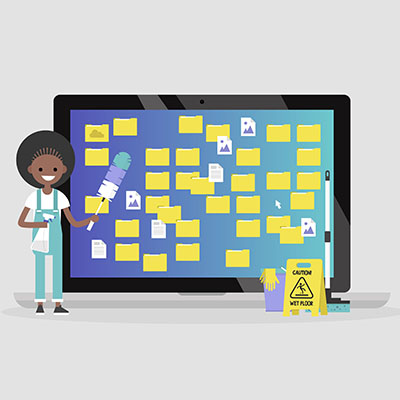With the latest version of Windows, Windows 11, users can leverage all manner of great productivity-boosting features to take full advantage of the new technology at their fingertips. Let’s look at some of the features that users of Windows 11 can use to make better use of their time with the operating system.
The Windows Clipboard Offers Far More Utility Historically, the Windows Clipboard had a one-and-done level of functionality. You could copy one clip into it and use it for the rest of the time you were on the computer… provided you never copied anything else. If you did, your original clip was lost. Nowadays, the Clipboard is far more capable than just this. Today, multiple clips can be stored and selected from—and what’s more, these clips can be stored in your Clipboard permanently, potentially making it far more convenient for you to replicate content that you come back to on a regular basis, from multiple devices. To view the complete Clipboard, press Windows Key + V. A window will open that displays all of the clips you’ve taken during your session. You can also identify anything you want to persist after your device restarts by selecting the three-dot icon on any copied content and selecting Pin. This is great if there’s any boilerplate you regularly need to paste into an email or document template, and it ensures that this content will be there until you actively delete it from your Clipboard. Focus Sessions Allow You to Eliminate Distractions For all the benefits that technology and its inherent connectivity bring, it does have one pretty significant drawback: it makes it far more difficult to focus on any one task, with all the reminders and notifications for other things that need to be done popping up and dinging, breaking your concentration. To address this, Windows 11 offers a feature called Focus sessions, which effectively puts the operating system into Do Not Disturb, muting notifications for a time that you determine. To start a session, search for clock in the Search box and access the Clock app. There, you’ll see the Focus sessions option, where you can set a duration for your focus session. If the session is 30 minutes or less, no breaks will be factored in, but longer sessions will have breaks automatically incorporated into your session unless you check the Skip breaks option. Click Start focus session to get down to business. You can even link your Spotify account to play music during your session, as well as set long-term goals for its use. Microsoft Teams is Accessible Via the Taskbar Many organizations have formalized the use of Teams as their internal communications platform of choice, which makes the decision to incorporate a quick-access tool for it into Windows 11 sound like a smart decision. The operating system now incorporates a simple version of Teams in the taskbar itself, allowing you to repeat your most recent activity on the platform—all you have to do is click the icon or press Windows Key + C. From there, you can start a video call via the Meet option or a text conversation via Chat. If these options aren’t enough, you can also Open Microsoft Teams properly via this easy-access menu. We hope these capabilities help you throughout your workday, along with the other tools that Windows 11 makes available to you! For assistance in other ways that your technology can work harder for you, give us a call at (336) 790-1000 today.
Your business uses software to function, but we would like you to consider the role that each of your applications fulfills for your business. Do you have the right amount of software for your company’s needs, or do you have a lot of redundant solutions that only complicate your infrastructure and operations? Today, we’ll discuss the different types of software your company might use so you can make educated decisions about applications you might implement for your needs.
Software is extremely important for businesses, so when you are creating the strategy and roster of applications you plan to use, you need to be smart about it. One way you can make the most out of your technology budget is to consider Software-as-a-Service (SaaS). With SaaS, your business can get the digital assets it needs at a price you can afford. Let’s discuss what makes SaaS so valuable for businesses.
Your business runs on software, whether it’s the systems you implement to get work done or the customer relations management software you use to communicate with the consumers of your goods or services. You’d be hard-pressed to find a business that doesn’t rely on software in some capacity, so it’s not a stretch to say that your business is only as effective as the solutions you implement.
Everyone’s job has some degree of minutiae involved. Not everything can be exciting: I mean even a stuntman sits around for most of the day before his or her death-defying scene happens. This week, we thought we’d go through the importance of these seemingly rote tasks and how instituting technology that allows you to automate more of them can actually help a business accomplish a lot.
Your Windows desktop can often get cluttered with icons, so it is helpful to have the ability to show or hide them so you can keep your focus on the task at hand. Let’s discuss how you can do this with your Windows PC.
Productivity suites are a dime a dozen, with Microsoft Office being perhaps the most well-known. However, there are plenty of other options out there, such as Google Workspace. How does Google Workspace hold up as a solution for productivity compared to its competition? Let’s take a look!
Productivity is at the heart of running a successful business, but it’s not always apparent to employees how their effort translates into value for the company. Is there a way to use technology to help fuel productivity and ensure employees understand the value that their productivity provides to your organization? The right tools can eliminate barriers to productivity and allow your employees to reach their full potential.
Businesses that utilize technology often try to make it last as long as possible to avoid the costs of overhauling their entire infrastructure. This can cause a lot of damage in the long term, though, especially if this practice leads to keeping technology longer than necessary. Let’s examine some of the variables that go into technology refreshes and how you can know when it’s time to do so.









